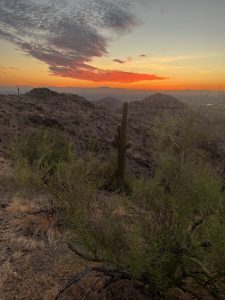Chapter 3a Part 1 – Ecosystems – Biomes
Chapter 3a Outline:
- Deserts
- Savannas
- Temperate Grasslands
- Chaparrals
- Temperate Forests
- Boreal (Taiga) Forests
- Tropical Rainforests
- Tundra (Artic and Alpine)
Learning Outcomes:
After studying chapter 3a, each student should be able to:
- 3.1 Describe the major biomes and ecosystems of the Earth
Note: Other topics related to ecosystems can be found in chapter 3b.
3.1 Ecosystems and Biomes
An ecosystem is a community of organisms (biota) and their abiotic (non-living) environment. Ecosystems can be small, such as the tide pools found near the rocky shores of many oceans, or larger areas, such as the Sonoran Desert. Biomes describe even larger areas of the earth’s surface, characterized by a particular community of flora and fauna, as well as physical (abiotic) features (Fig. 1).
There are three broad categories of biomes based on their general environment: freshwater, marine (saltwater), and terrestrial. Within these three categories are more specific ecosystem types based on the environmental habitat and organisms present.
Freshwater ecosystems are the least common, occurring on only 1.8 percent of Earth’s surface. These systems comprise lakes, rivers, streams, and springs. Marine (salt water) ecosystems are the most common, comprising 75 percent of Earth’s surface and consisting of three basic types: shallow ocean, deep ocean water, and deep ocean bottom. Terrestrial ecosystems include all life on land, from the permanently frozen poles to the warm and lush rainforests, and every area of land in between.
A. Terrestrial Biomes
Terrestrial Biomes are large-scale, land based environments that are distinguished by characteristic temperature ranges and amounts of precipitation. Together, these two variables determine the types of vegetation and animal life that can exist in those areas. Because each biome is defined by climate, the same biome can occur in geographically distinct areas with similar climates (Figure 1.).

Figure 1. Each of the world’s major biomes is distinguished by characteristic temperatures and amounts of precipitation. Polar ice and mountains are also shown. (Credit: Attribution: “Biomes Map” by OpenStax is licensed under CC BY 4.0)
In addition to temperature ranges, precipitation amounts, and the characteristic plants and animals of each biome, biomes also differ significantly in their productivity. Productivity refers to the rate at which energy (captured primarily from sunlight) is added to organisms in the form of biomass. Biomass refers to the amount of matter stored in the bodies of all living organisms. Primary productivity refers to the process by which photosynthetic organisms, such as plants and algae, incorporate energy from the sun, carbon dioxide from the atmosphere, and water into the production of organic compounds.
Categories of Terrestrial Biomes
Most biologists recognize eight major terrestrial biomes: deserts, savannas, chaparrals, temperate grasslands, temperate forests, boreal forests, tundra, and tropical rainforests. The following video gives a brief overview of each of these biomes:
Next Generation Science. (2022, May 9). Earth’s Biomes. [Video]. YouTube. https://youtu.be/yZRsyiOl3kk?si=3AX9TzdGncdtcrf4
1. Deserts
There are two main types of deserts: subtropical deserts and cold deserts.
Subtropical deserts exist between 15o and 30o north and south latitude and are centered on the Tropic of Cancer and the Tropic of Capricorn.
Subtropical deserts are very dry, because evaporation typically exceeds precipitation. Daytime soil surface temperatures can exceed 60oC (140oF) and nighttime temperatures may approach 0oC (32oF). Subtropical deserts are characterized by low annual precipitation of less than 30 cm (12 in) with little monthly variation and unpredictable rainfall. In some cases, the annual rainfall can be as low as 2 cm (0.8 in).
The relatively low species diversity of desert biomes is closely related to its low and unpredictable precipitation. Despite the relatively low diversity, desert species exhibit fascinating adaptations to the harshness of their environment. Very dry deserts lack perennial vegetation that lives from one year to the next; instead, many plants are annuals that grow quickly and reproduce when rainfall occurs, then they die. Perennial plants in deserts are characterized by adaptations that conserve water: deep roots, reduced foliage, and water-storing stems (figure 2). Seed plants in the desert produce seeds that can lie dormant for extended periods between rains. Most animal life in subtropical deserts has adapted to a nocturnal life, spending the hot daytime hours beneath the ground.

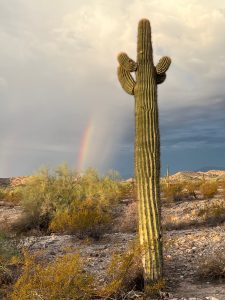
Figure 2. To reduce water loss, many desert plants have tiny leaves or not leaves at all. The leaves of ocotillo (Fouquieria splendens), shown here in the Sonoran Desert near Gila Bend, Arizona appear only after rainfall, and then are shed. (Credit: Attribution: “Desert Plant Adaptation” by OpenStax is licensed under CC BY 4.0 Saguaro cactus photos are from South Mountain Park, Phoenix, Arizona (photos by Paul Bosch).
Although all deserts are characterized by relatively low amounts of rainfall, deserts in different geographical locations can house very different organisms. For example, saguaro cacti are only found in the Sonoran Desert located in the Southwestern United States and Mexico, which has a relatively high amount of rainfall compared to other deserts. The Mojave desert also found in the Southwestern United States lacks Saguaros. The Saharan Desert of northern Africa and the Namib Desert of southern Africa are primarily characterized by sand dunes with limited and scattered vegetation.
Cold deserts, in contrast, have freezing temperatures during the winter and any precipitation is in the form of snowfall. Examples of cold deserts include the Gobi Desert in northern China and southern Mongolia and the Great Basin Desert in the western United States.
Although the following video on the Sonoran Desert is not licensed to be embedded to watch in this eBook, follow the link to the author’s copywrited video to view this short video:
https://youtu.be/utFhmlfbBU0?si=H6SeDXAASorTzNHZ.
Another video follows that has information on all deserts of the world:
National Geographic. (2019, June 28). Deserts 101. [Video – YouTube]. https://www.youtube.com/watch?v=n4crvs-KTBwhttps://youtu.be/yZRsyiOl3kk?si=3AX9TzdGncdtcrf4
2. Savannas
Savannas are grasslands with scattered trees and are found in Africa, South America, and northern Australia (figure 3). Savannas are hot, tropical areas with temperatures averaging from 24oC –29oC (75oF –84oF) and an annual rainfall of 51–127 cm (20–50 in). Savannas have an extensive dry season and consequent fires. As a result, there are relatively few trees scattered in the grasses and forbs (herbaceous flowering plants) that dominate the savanna.
Savannas are home to a wide diversity of animals. The largest land mammal can be found there (the African elephant), as well as a wide diversity of herbivores, including 40 species of hoofed mammals (Figure 3). Each different herbivore has its own preference for grasses and, allowing up to 16 different species of grazers, for example, to live together at one time.
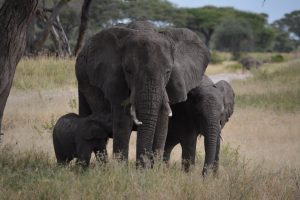
Figure 3. Elephant Family in Savanna of Tarangire National Park, Tanzania. (Credit: photo by Paul Bosch)
Antelopes, zebras, giraffes, buffalo, and other herbivores all eat different grasses, shrubs, and trees, focusing in on their preferred plant foods. This can be related to height of the plant but can also be caused by the plants themselves. Some plants produce chemicals that make them taste bad to some animals but not others. This allows a large diversity of animals to live in the same biome without depleting their food supply.
The many herbivores, of course, are the food supply for a diverse range of predators, like lions, cheetahs and leopards. Also present are smaller jackals and hyenas and many species of predatory birds. These carnivores tend to focus on different prey items. For example, the type of grazers a pride of lions can bring down is very different than what a lone cheetah might try to hunt (Figure 4).
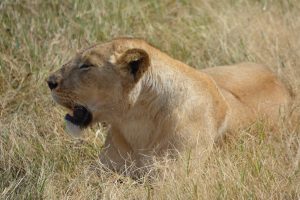
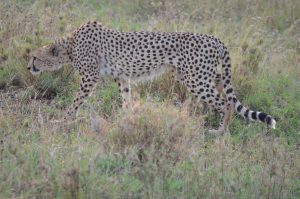
Figure 4. A lion and a cheetah in the Serengeti National Park, Tanzania (Credit: photos by Paul Bosch)
The following video shows some of the diverse plant and animal life found in the Savanna:
MooMoo Math and Science. (2018, Dec 22). Savanna Grassland – Biomes of the World [Video]. YouTube. https://youtu.be/k17R7Se28hU
3. Temperate Grasslands
Temperate grasslands are found throughout central North America, where they are also known as prairies, and in Eurasia, where they are known as steppes (Figure 5.). Africa and South America also have large areas of grassland. Temperate grasslands have pronounced annual fluctuations in temperature with hot summers and cold winters. The annual temperature variation produces specific growing seasons for plants. Plant growth, primarily grasses, is possible when temperatures are warm enough to sustain this growth, which occurs in the spring, summer, and fall.

Figure 5. The American bison (Bison bison), commonly called the buffalo, is a grazing mammal that once populated American prairies in huge numbers. Attribution: Jack Dykinga, USDA Agricultural Research Service accessed from OpenStax is licensed under CC BY 4.0
Annual precipitation ranges from 25.4 cm to 88.9 cm (10–35 in). Temperate grasslands have few trees except for those found growing along rivers or streams. The dominant vegetation tends to consist of grasses. The treeless condition is maintained by low precipitation, frequent fires, and grazing. The vegetation is very dense and the soils are fertile because the subsurface of the soil is packed with the roots and rhizomes (underground stems) of these grasses. The roots and rhizomes act to anchor plants into the ground and replenish the organic material (humus) in the soil when they die and decay.
Fires, which are a natural disturbance in temperate grasslands, can be ignited by lightning strikes. When fire is suppressed in temperate grasslands, the vegetation eventually converts to scrub and dense forests. Often, the restoration or management of temperate grasslands requires the use of controlled burns to suppress the growth of trees and maintain the grasses.
Prairie grasslands once spanned central North America from the boreal forest in northern Canada down into Mexico. Natural prairie ecosystems are now all but gone, replaced by crop fields, pasture lands, and urban and suburban sprawl. Many of the species survive in much lower numbers, but the hugely productive grassland ecosystem that was responsible for creating our most productive agricultural soils is now gone. As a consequence, their soils are now being depleted unless they are maintained artificially by fertilizers and pesticides (at great expense). The decline in soil productivity occurs because the organisms and ecological cycles in the original ecosystem have been lost.
The following video describes features and organisms of temperate grasslands across the earth:
Cotnoir, Tori (2015). Temperate Grasslands. [Video- YouTube] https://youtu.be/9FM7TXwgVsI
4. Chaparrals
The chaparral ecosystem can also be called a scrub forest and is found near the coast of California, along the Mediterranean Sea, and along the southern coast of Australia (Figure 6). The annual rainfall in this biome ranges from 65 cm to 75 cm (25.6–29.5 in) and the majority of the rain falls in the winter. Summers are very dry and many chaparral plants are dormant during the summertime. The chaparral vegetation is dominated by shrubs and is adapted to periodic fires, with some plants producing seeds that require fire to germinate. The ashes left behind after a fire are rich in nutrients like nitrogen and fertilize the soil, promoting plant regrowth.

Figure 6. The chaparral is dominated by shrubs. (Credit: Attribution: Miguel Vieira accessed from OpenStax is licensed under CC BY 4.0)
The following video describes the chaparral ecosystem, with a focus on this biome in California:
Hao, Erica (2009, Sept 21). Chaparral Ecosystem [Video – You Tube]. https://youtu.be/vrSMVYnXb2M
5. Temperate Forests
Temperate forests are the most common biome in eastern North America, Western Europe, Eastern Asia, Chile, and New Zealand. Temperatures range between –30oC and 30oC (–22oF to 86oF) and drop to below freezing on an annual basis. These temperatures mean that temperate forests have defined growing seasons during the spring, summer, and early fall. Precipitation is relatively constant throughout the year and ranges between 75 cm and 150 cm (29.5–59 in).
Deciduous trees, which lose their leaves each fall and remain leafless throughout the winter, are the dominant plant in temperate forests (Figure 7.). Thus, little photosynthesis occurs during the dormant winter period. Each spring, new leaves appear as temperature increases. The trees of the temperate forests leaf out and shade much of the ground. The soils of the temperate forests are rich in inorganic and organic nutrients due to a thick layer of leaf litter on forest floors. As this leaf litter decays, nutrients are returned to the soil. The leaf litter also protects soil from erosion, insulates the ground, and provides habitats for invertebrates like beetles and ants and their predators, such as lizards and amphibians.
Temperate forests include a broad range of climates, making them home to diverse species of animals. These include predators such as bears and mountain lions, and herbivorous animals such as squirrels and deer. A great variety of birds are also adapted to various plant types among this species rich biome.

Figure 7. Deciduous trees are the dominant plant in the temperate forest. (Credit: Oliver Herold accessed from OpenStax is licensed under CC BY 4.0)
The following video describes the temperate forest ecosystem, including the plants and animals found in this biome:
Next Generation Science. (2021, Nov 20). Temperate Forest Ecosystems. [Video – YouTube]. https://youtu.be/BwKU3FVoGMk
6. Boreal (Taiga) Forests
The boreal forest, also known as taiga or northern coniferous forest, is found roughly between 50o and 60o north latitude across most of Canada, Alaska, Russia, and northern Europe. Boreal forests are also found above a certain elevation (and below high elevations where trees cannot grow) in mountain ranges throughout the Northern Hemisphere. This biome has cold, dry winters and short, cool, wet summers. The annual precipitation is from 40 cm to 100 cm (15.7–39 in) and usually takes the form of snow; relatively little evaporation occurs because of the cool temperatures.
The long and cold winters in the boreal forest have led to the predominance of cold-tolerant cone-bearing plants (Figure 8). These are evergreen coniferous trees like pines, spruce, and fir, which retain their needle-shaped leaves year-round. Soils in boreal forest regions tend to be acidic with little available nitrogen. Coniferous trees are able to survive in a nitrogen-limited environment since they do not have to make new needles each year.

Figure 8. The boreal forest (taiga) has low lying plants and conifer trees. (Credit: Attribution: L. B. Brubaker accessed from OpenStax is licensed under CC BY 4.0 .)
The aboveground biomass of boreal forests is high because these slow-growing tree species are long-lived and accumulate biomass over time. The structure of a boreal forest is often only a tree layer and a ground layer, which leads to relatively low species diversity. When conifer needles are dropped, they decompose slowly; therefore, nutrients are not recycled quickly.
The following video shows the taiga biome, including its most abundant plants and animals:
MooMoo Math and Science. (2018, Dec 13). The taiga (boreal forest) – biomes of the world. [Video -YouTube] . https://youtu.be/gjcs2P9PcMg
7. Tropical Rainforests
Tropical rainforests, found in equatorial regions, are the most biodiverse terrestrial biome. This biodiversity stems from the relatively stable temperature and sunlight profiles of tropical rainforests in comparison to other terrestrial biomes. Average temperatures range from 20oC to 34oC (68oF to 93oF) throughout all months of the year. This lack of temperature seasonality leads to year-round plant growth rather than just seasonal growth. In contrast to other ecosystems, a consistent daily amount of sunlight (11–12 hours per day year-round) provides more solar radiation and therefore more opportunity for primary productivity.
The annual rainfall in tropical rainforests ranges from 125 to 660 cm (50–200 in) with some seasonal variation. Tropical rainforests have wet months in which there can be more than 30 cm (11–12 in) of precipitation, as well as dry months in which there are fewer than 10 cm (3.5 in) of rainfall. However, the driest month of a tropical rainforest can still exceed the annual rainfall of some other biomes, such as deserts. Tropical rainforests have high net primary productivity, because the annual temperatures and precipitation values support rapid plant growth. However, the high amount of rainfall also leaches nutrients from the soils of these forests
The vegetation is characterized by plants with spreading roots and broad leaves that fall off throughout the year (Figure 9). The vegetation of tropical rainforests is characterized by vertical layering resulting in the formation of distinct habitats for animals within each layer. On the forest floor is a sparse layer of plants and decaying plant matter. Above that is an understory of short, shrubby foliage. A layer of trees rises above this understory and is topped by a closed upper canopy—the uppermost overhead layer of branches and leaves. Some additional trees emerge through this closed upper canopy. These layers provide diverse and complex habitats for the variety of plants, animals, and other organisms. Many species of animals use the variety of plants and the complex structure of the tropical wet forests for food and shelter.
This biodiversity is under extraordinary threat primarily through logging and deforestation for agriculture. This loss of biodiversity is especially concerning for humans as tropical rainforests have also been described as nature’s pharmacy because of the potential for the production of new drugs from the many chemicals produced by the huge diversity of plants, animals, and other organisms.


Figure 9. Tropical rainforests, also known as tropical wet forests, such as these forests along the Madre de Dios river, Peru, near the Amazon River, have high species diversity. (Credit: Attribution: Roosevelt Garcia accessed from OpenStax is licensed under CC BY 4.0 Red eyed tree frog near La Tigra Rainforest Lodge, Fortuna, Costa Rica (photo by Paul Bosch).
The following National Geographic video gives an informative overview of the rainforest biome:
National Geographic. (2022, Sept 27) Rainforests 101. [Video – YouTube]. https://youtu.be/3vijLre760w
8. Tundra
The Arctic tundra lies north of the subarctic boreal forests and is located throughout the Arctic regions of the Northern Hemisphere. Tundra also exists at elevations above the tree line on mountains, where it is called Alpine tundra. The average winter temperature is –34°C (–29.2°F) and the average summer temperature is 3°C–12°C (37°F –52°F). Plants in the tundra have a short growing season of approximately 50–60 days. However, during this time, there is almost 24 hours of daylight and plant growth is rapid. The annual precipitation of the Arctic tundra is low (15–25 cm or 6–10 in) with little annual variation in precipitation. There is also little evaporation because of the cold temperatures.
Plants in the tundra are generally low to the ground and include low shrubs, grasses, lichens, and small flowering plants (Figure 10). There is little species diversity, low net primary productivity, and low above-ground biomass. The soils of the Arctic tundra may remain in a perennially frozen state referred to as permafrost. The permafrost makes it impossible for roots to penetrate far into the soil and slows the decay of organic matter, which inhibits the release of nutrients from organic matter. The melting of the permafrost in the brief summer provides water for a burst of productivity while temperatures and long days permit it. During the growing season, the ground of the Arctic tundra can be completely covered with plants or lichens.

Figure 10. Low-growing plants such as shrub willow dominate the tundra landscape, shown here in the Arctic National Wildlife Refuge. (Credit: Attribution: USFWS Arctic National Wildlife Refuge accessed from OpenStax is licensed under CC BY 4.0)
Alpine tundras have similar small and slow growing plants, but are found in mountain top areas across the planet. The long periods of frozen earth and short growing seasons of these high altitude areas have similar effects on the general ecology and plant growth as can be found in the distant Arctic regions of the earth.
The following National Geographic video gives an informative overview of the tundra biome:
National Geographic. (2018, Feb 2). What are Tundras? [Video -YouTube]. https://youtu.be/RT6x5GVPFG8
B. Aquatic Biomes
Like terrestrial biomes, aquatic biomes are influenced by a series of abiotic factors. The aquatic medium—water— has different physical and chemical properties than air, however. Even if the water in a pond or other body of water is perfectly clear (there are no suspended particles), water, on its own, absorbs light. As one descends into a deep body of water, there will eventually be a depth which the sunlight cannot reach. The importance of light in aquatic biomes is central to the communities of organisms found in both freshwater and marine ecosystems.
1. Marine Biomes
a. Ocean
The ocean is the largest marine biome. It is a continuous body of saltwater that is relatively uniform in chemical composition; in fact, it is a weak solution of mineral salts and decayed biological matter. Within the ocean, coral reefs are a second kind of marine biome. Estuaries, coastal areas where saltwater and freshwater mix, form a third unique marine biome.
The ocean is categorized by several areas or zones (Figure 11). All of the ocean’s open water is referred to as the pelagic realm (or zone). The benthic realm (or zone) extends along the ocean bottom from the shoreline to the deepest parts of the ocean floor. Within the pelagic realm is the photic zone, which is the portion of the ocean that light can penetrate (approximately 200 m or 650 ft). At depths greater than 200 m, light cannot penetrate; thus, this is referred to as the aphotic zone. The majority of the ocean is aphotic and lacks sufficient light for photosynthesis. These realms and zones are relevant to freshwater lakes as well.
VISUAL CONNECTION

Figure 11. The ocean is divided into different zones based on water depth and distance from the shoreline.
The physical diversity of the ocean is a significant influence on plants, animals, and other organisms. Each zone has a distinct group of species adapted to the biotic and abiotic conditions particular to that zone:
The intertidal zone, which is the zone between high and low tide, is the oceanic region that is closest to land (Figure 12). In some cases, the intertidal zone is a sandy beach, but it can also be rocky or muddy. The intertidal zone is an extremely variable environment because of action of tidal ebb and flow. Organisms are exposed to air and sunlight at low tide and are underwater at other times, especially during high tide. Therefore, living things that thrive in the intertidal zone are adapted to being dry for long periods of time. The shore of the intertidal zone may also be repeatedly struck by waves, and the organisms found there are adapted to withstand damage from their pounding action. The exoskeletons of shoreline crustaceans (such as the shore crab, Carcinus maenas) are tough and protect them from desiccation (drying out) and wave damage. Another consequence of the pounding waves is that few algae and plants establish themselves in the constantly moving rocks, sand, or mud.
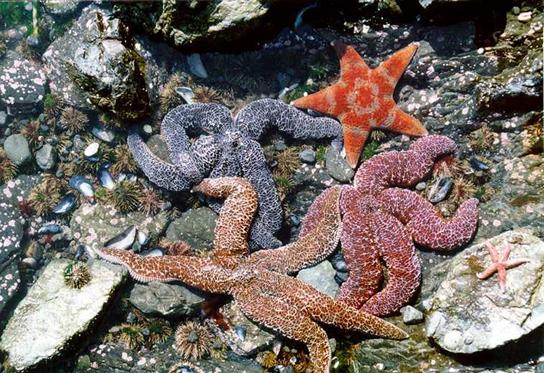
Figure 12. Sea urchins, mussel shells, and starfish are often found in the intertidal zone, shown here in Kachemak Bay, Alaska. (Photo Credit: National Oceanic and Atmospheric Administration)
The neritic zone (see location in Figure 11 above) extends from the intertidal zone to depths of about 200 m (or 650 ft) at the edge of the continental shelf (the underwater landmass that extends from a continent). Since light can penetrate this depth, photosynthesis can still occur in the neritic zone. The water here contains silt and is well-oxygenated, low in pressure, and stable in temperature. Phytoplankton and floating Sargassum (a type of free-floating marine seaweed) provide a habitat for some sea life found in the neritic zone. Zooplankton, protists, small fishes, and shrimp are found in the neritic zone and are the base of the food chain for most of the world’s fisheries.
Beyond the neritic zone is the open ocean area known as the pelagic or open oceanic zone . Abundant plankton serve as the base of the food chain for larger animals such as whales and dolphins. Nutrients are scarce and this is a relatively less productive part of the marine biome. When photosynthetic organisms and the protists and animals that feed on them die, their bodies fall to the bottom of the ocean, where they remain. Organisms that live in the aphotic zone include sea cucumbers (phylum Echinodermata) and other organisms that survive on the nutrients contained in the dead bodies of organisms in the photic zone.
Beneath the pelagic zone is the benthic realm, the deep-water region beyond the continental shelf (Figure 13). The bottom of the benthic realm is composed of sand, silt, and dead organisms. Temperature decreases with depth. This is a nutrient-rich portion of the ocean because of the dead organisms that fall from the upper layers of the ocean. Because of this high level of nutrients, a diversity of fungi, sponges, sea anemones, marine worms, sea stars, fishes, and bacteria exist.

Figure 13. A bottom-dwelling community found in the European Arctic. (Credit: Image courtesy of Arctic Exploration 2002, Juterzenka, Piepenburg, Schmid, NOAA/OER.)
The deepest part of the ocean is the abyssal zone, which is at depths of 4000 m or greater. The abyssal zone is very cold and has very high pressure, high oxygen content, and low nutrient content. There are a variety of invertebrates and fishes found in this zone, but the abyssal zone does not have plants because of the lack of light. Hydrothermal vents are found primarily in the abyssal zone; chemosynthetic bacteria utilize the hydrogen sulfide and other minerals emitted from the vents. These chemosynthetic bacteria use the hydrogen sulfide as an energy source and serve as the base of the food chain found in the abyssal zone.
b. Coral Reefs
Coral reefs are ocean ridges formed by marine invertebrates, comprising mostly cnidarians and mollusks, living in warm shallow waters within the photic zone of the ocean. They are found within 30˚ north and south of the equator. The Great Barrier Reef is perhaps the best-known and largest reef system in the world—visible from the International Space Station! This massive and ancient reef is located several miles off the northeastern coast of Australia. Other coral reef systems are fringing islands, which are directly adjacent to land, or atolls, which are circular reef systems surrounding a former landmass that is now underwater.
The coral organisms (members of phylum Cnidaria) are colonies of saltwater polyps that secrete a calcium carbonate skeleton. These calcium-rich skeletons slowly accumulate, forming the underwater reef (Figure 14). Corals found in shallower waters (at a depth of approximately 60 m or about 200 ft) have a mutualistic relationship with photosynthetic unicellular algae. The relationship provides corals with the majority of the nutrition and the energy they require. The waters in which these corals live are nutritionally poor and, without this mutualism, it would not be possible for large corals to grow. Some corals living in deeper and colder water do not have a mutualistic relationship with algae; these corals obtain energy and nutrients using stinging cells called cnidocytes on their tentacles to capture prey. Coral reef ecosystems have high biodiversity. It is estimated that over 4,000 species of fish inhabit coral reefs along with the invertebrates, algae, and plankton they feed upon.

Figure 14. Coral reefs are formed by the calcium carbonate skeletons of coral organisms, which are marine invertebrates in the phylum Cnidaria. (Photo credit: Terry Hughes)
The following National Geographic video gives an informative and interesting overview of the coral reef ecosystem:
National Geographic. (2017, Nov 7). Coral Reefs 101 – National Geographic [Video -YouTube] https://youtu.be/RT6x5GVPFG8
c. Estuaries: Where the Ocean Meets Fresh Water
Estuaries are biomes that occur where a source of freshwater, such as a river, meets the ocean. Therefore, both freshwater and saltwater are found in the same vicinity, resulting in a diluted (brackish) saltwater. Estuaries form protected areas where many of the young offspring of crustaceans, mollusks, and fish begin their lives, which also creates important breeding grounds for other animals. Salinity is a very important factor that influences the organisms and the adaptations of the organisms found in estuaries. The salinity of estuaries varies considerably and is based on the rate of flow of its freshwater sources, which may depend on the seasonal rainfall. Once or twice a day, high tides bring salt water into the estuary. Low tides occurring at the same frequency reverse the current of salt water.
The short-term and rapid variation in salinity due to the mixing of fresh water and salt water is a difficult physiological challenge for the plants and animals that inhabit estuaries. Many estuarine plant species are halophytes: plants that can tolerate salty conditions. Halophytic plants are adapted to deal with the salinity resulting from saltwater on their roots or from sea spray. In some halophytes, filters in the roots remove the salt from the water that the plant absorbs. Other plants are able to pump oxygen into their roots. Animals, such as mussels and clams (phylum Mollusca), have developed behavioral adaptations that expend a lot of energy to function in this rapidly changing environment. When these animals are exposed to low salinity, they stop feeding, close their shells, and switch from aerobic respiration (in which they use gills to remove oxygen from the water) to anaerobic respiration (a process that does not require oxygen and takes place in the cytoplasm of the animal’s cells). When high tide returns to the estuary, the salinity and oxygen content of the water increases, and these animals open their shells, begin feeding, and return to aerobic respiration.
The following video gives an informative description of estuaries:
U.S. Environmental Protection Agency. (2011, Sept 11). What’s an Estuary – Now you Know. [Video -YouTube] https://youtu.be/XLumSN4G5P4
2. Freshwater Biomes
Freshwater biomes include lakes and ponds (standing water), rivers and streams (flowing water), and wetlands. Humans rely on freshwater biomes to provide ecosystem benefits, which are aquatic resources for drinking water, crop irrigation, sanitation, and industry.
The following video gives an overview of the various ecosystems found in the freshwater biomes:
MooMoo Math and Science. (2017, Aug 11). Freshwater Biomes [Video -YouTube] https://youtu.be/k17R7Se28hU
a. Lakes and Ponds
Lakes and ponds can range in area from a few square meters to thousands of square kilometers (Figure 15). Temperature is an important abiotic factor affecting living things found in lakes and ponds. In the summer, thermal stratification of lakes and ponds occurs when the upper layer of water is warmed by the sun and does not mix with deeper, cooler water. Light can penetrate within the photic zone of the lake or pond. Phytoplankton (algae and cyanobacteria) are found here and carry out photosynthesis, providing the base of the food web of lakes and ponds. Zooplankton (invertebrates), such as rotifers and larvae and adult crustaceans, consume these phytoplankton. At the bottom of lakes and ponds, bacteria in the aphotic zone break down dead organisms that sink to the bottom.

Figure 15. Reeds next to a lake. (Credit: Tom Marc; Attribute: Content License – Pixabay Free Images)
The following video provides information about lakes and ponds and the thermal stratification mentioned above:
Aquatic Science Lessons with Dr Rudy Rosen (2015, Apr 17) Lakes and Ponds Summary Overview. [Video – YouTube] https://youtu.be/PEJOtVap6-8
b. Rivers and Streams
Rivers and streams are continuously moving bodies of water that carry large amounts of water from the source, or headwater, to a lake or ocean. The largest rivers include the Nile River in Africa, the Amazon River in South America, and the Mississippi River in North America.
Abiotic features of rivers and streams vary along the length of the river or stream. Streams begin at a point of origin referred to as source water. The source water is usually cold, low in nutrients, and clear (Figure 16). The channel (the width of the river or stream) is narrower than at any other place along the length of the river or stream. Because of this, the current is often faster here than at any other point of the river or stream.
The fast-moving water results in minimal silt accumulation at the bottom of the river or stream; therefore, the water is usually clear and free of debris. Photosynthesis here is mostly attributed to algae that are growing on rocks. An additional input of energy can come from leaves and other organic material that fall downstream into the river or stream, as well as from trees and other plants that border the water. When the leaves decompose, the organic material and nutrients in the leaves are returned to the water. Plants and animals have adapted to this fast-moving water. For instance, leeches (phylum Annelida) have elongated bodies and suckers on the anterior and ventral areas of the body. These suckers attach to the substrate, keeping the leech anchored in place, and are also used to attach to their prey.
As the river or stream flows away from the source, the width of the channel gradually widens and the current slows. This slow-moving water, caused by the gradient decrease and the volume increase as tributaries unite, has more sedimentation. Therefore, the water will not be as clear as it is near the source. The water is also warmer. Worms (phylum Annelida) and insects (phylum Arthropoda) can be found burrowing into the mud. The higher order predator vertebrates (phylum Chordata) include waterfowl, frogs, and fishes. These predators must find food in these slow moving, sometimes murky, waters and, unlike the trout in the waters at the source, these vertebrates may not be able to use vision as their primary sense to find food. Instead, they are more likely to use taste or chemical cues to find prey.

Figure 16. McKenzie River in central Oregon. (Credit: Content License – Pixabay Free Images)
c. Wetlands
Wetlands are environments in which the soil is either permanently or periodically saturated with water. Wetlands are different from lakes because wetlands are shallow bodies of water whereas lakes vary in depth. Emergent vegetation consists of wetland plants that are rooted in the soil but have portions of leaves, stems, and flowers extending above the water’s surface. There are several types of wetlands including marshes, swamps, bogs, mudflats, and salt marshes (Figure 17). Wetlands play an important ecological role during intense storms, such as tropical storms and hurricanes. Storm surge from the ocean often overflows into the wetlands. When wetlands are filled in for development purposes, the stormwater no longer has a place to go, negatively impacting human property and life due to flooding in the area where the wetland existed and in the surrounding areas.

Figure 17. Located in southern Florida, Everglades National Park is a vast array of wetland environments, including sawgrass marshes, cypress swamps, and estuarine mangrove forests. Here, a great egret walks among cypress trees. (credit: National Park Service)

